Marietta Burros
-
No cell phones
-
No internet or wifi
-
No TV
And except for our trusty Howie, no electricity, no lights, water, shelter. No humans anywhere. No emergency services. Absolutely nobody to help if you cried out. We are 50 miles from the nearest town of 4,000. And we love it.
Why? Here is the view from our camp site:
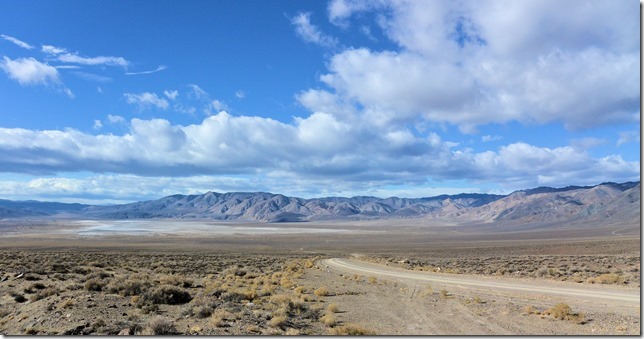
And these are the folks who keep us company in our remoteness:
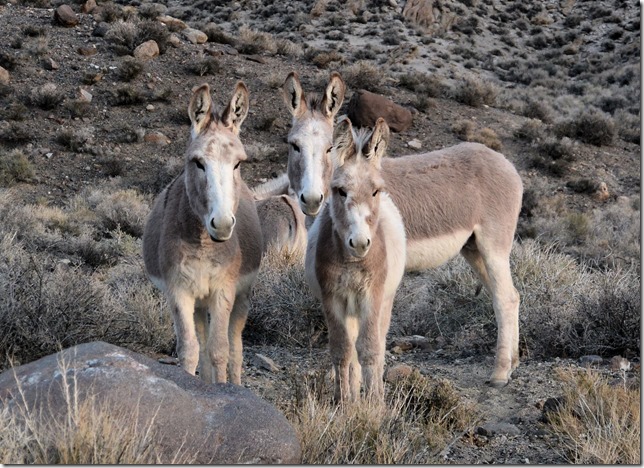
We are in the Marietta Wild Horse and Burro Area, a special region allocated by the BLM for these non-indigenous but desert-charismatic creatures. See the link:
http://www.blm.gov/nv/st/en/fo/carson_city_field/blm_programs/recreation/marietta.html
There are only 107 burros (maximum) in a huge area of about 300 square miles, but they still make their marks (footprints and dung piles), and it is very easy to find them, usually around sunset. They are now relatively tame (not having been shot at by jealous ranchers), and we can approach them to within 25 yards (in Ralph). I’m not sure how they would regard us if we were on foot.
Today (Saturday), we set out to explore the area. This is a daunting task, for the area we are in, encompassed by paved roads, is much larger than the burro sanctuary. In fact, during the course of the day, we were able to see only a fraction of the region, even though we navigated more than 45 miles of rough, remote dirt roads crossing the distance. If you want the details, we are camped at coordinates 38:14:12 x –118:16:34. If you have only a road map, find Bishop, CA and follow highway 360 up into Nevada. Just before you get to highway 95, the Burro Area is off to the northwest.
Today’s trekking took us past the “town” of Marietta, really just a place for a few folks to stay while they worked the mines in the area. We don’t have any information on what’s being mined – there are many minerals that saw productivity in Nevada over the last 100 years. Judging by the murderously difficult roads leading to the mines (one of which we explored in 4×4 compound low), we have to assume that not a lot of ore-based mining occurs, due to transportation difficulties. That leaves pretty much gold and silver as the present-day prospects. But that’s just a guess.
Our travels lead us through rugged terrain that gets more rugged with each mile.
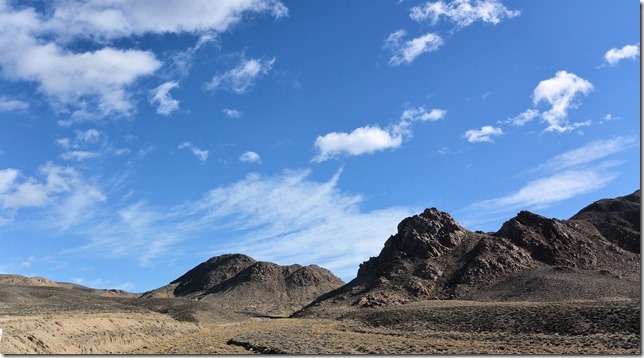
We are very, very glad of the many enhancements to Ralph, enabling him to negotiate some truly challenging paths. We also have peace-of-mind in the complement of spare gas, water, tools, winch, parts, and especially the satellite InReach communicator which would allow us to contact help in the case of a drastic breakdown or medical emergency. Some of you have received messages from InReach, but not many because the recipients’ emails must be hand-coded. For those who haven’t seen this linkage yet, you can see our last location and track by browsing to www.explore.delorme.com/greg.illes — and if you wish, you can message us (via satellite) from that site.
Some of the sights we encounter along the way are typical desert, old buildings and structures that have seen more useful times and better days.
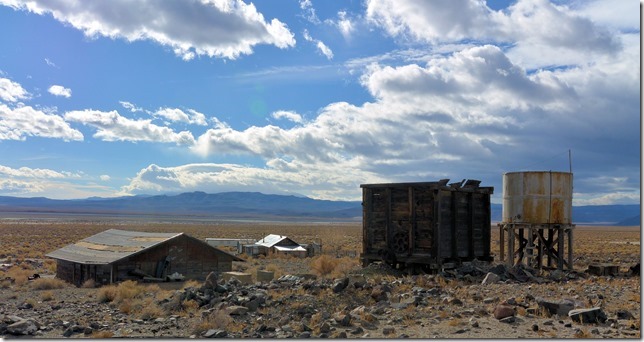
Others are more enigmatic, generating miles-long conversations about their possible purpose or use.
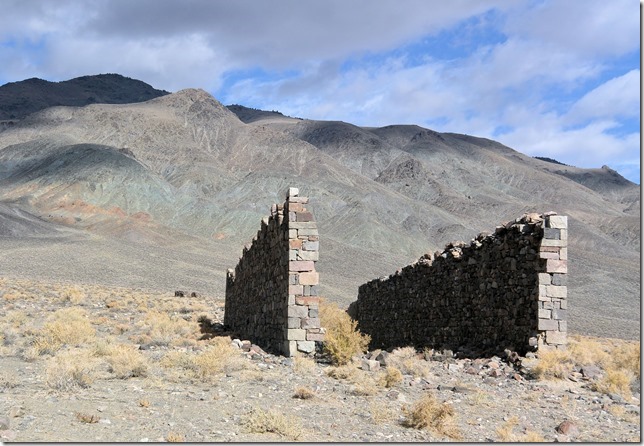
Other desert scenes prompt the mysterious: who would pay money for this?
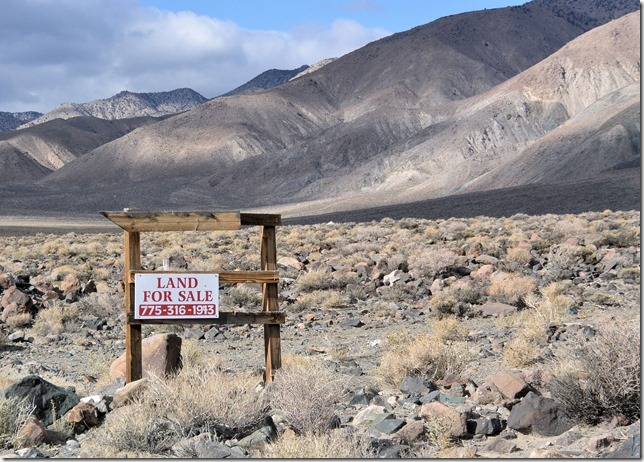
Or the pragmatic: I need some shelter, but I can’t reach the doorway.
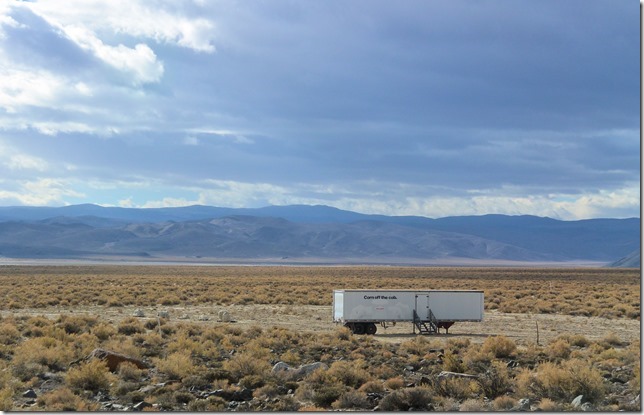
Or the ultimately iconic: old, weathered wood surrounding an extinct windmill, and not too far from the essential outhouse. There were blankets and toilet paper in residence – this is Cow Camp and is still (seasonally) in use.
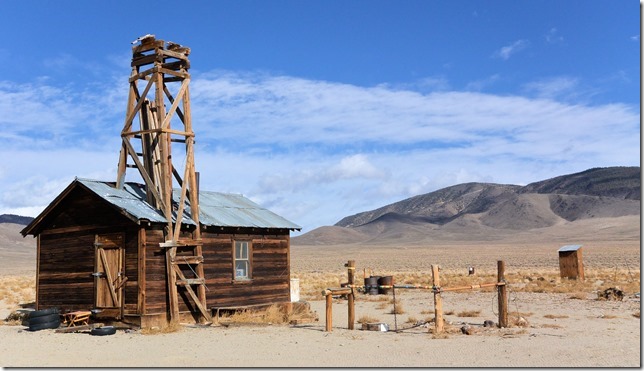
We wound our way past ancient and modern mines, ranches, and barely visible tracks leading to who-knows-where in the vastness of the desert. Enroute, we encountered the single human of the day, a game warden out checking that the local hunters were on the up-and-up. He was a dyed-in-the-wool Nevadan, deeply appreciative of the space and freedom afforded by this unique state.
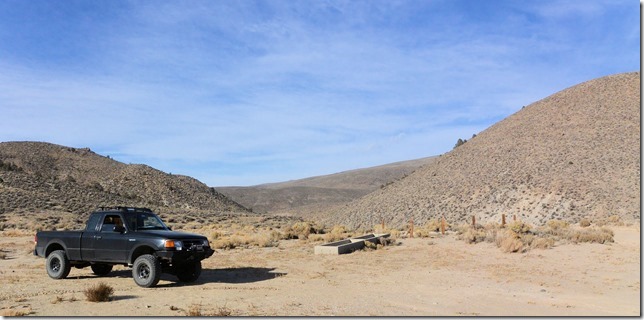
For many miles of our trek, we would see the unmistakable evidence of our desert companions, the wild burros. In some areas, this collection of tracks over time would go for miles. Some were fresh, some were well-worn by wind and weather.
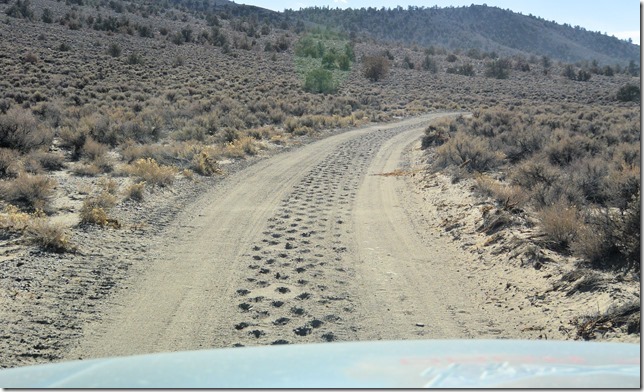
As we worked our way through one mountain pass, we came across this humorist’s reaction to a gigantic boulder poised to roll into our pathway. Cracked us up.
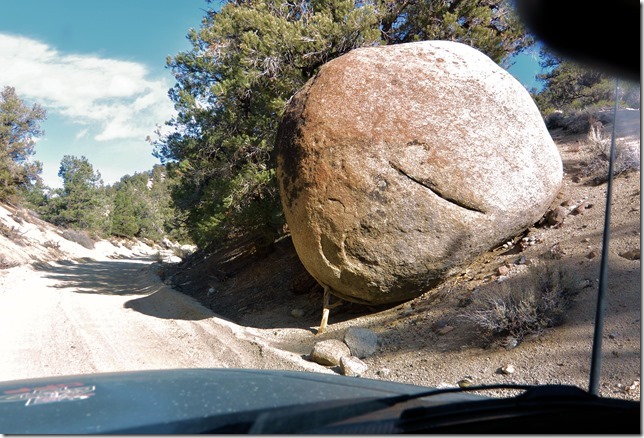
It got pretty late in the day, especially for November, so we elected to take the “shortcut” back home to camp. Even though it was twice the distance, we spent only one hour instead of four in the trip. This, even though we encountered one of Nevada’s famous dust storms enroute.
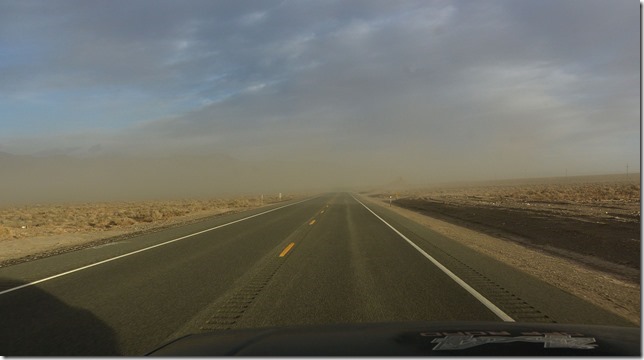
It was an interesting, beautiful, strenuous, but peaceful day. Life, as you know, is good.

love the rock poised to roll onto the road. Can’t wait to see more of your stuff, especially rv upgrades. I am currently building a rv out of a 18 foot cargo trailer. Looking for all the help I can find.
Hey Jerry,
I haven’t been doing much posting of late (Lyme and Wuflu put a crimp in things), and nothing in upgrades. Your project sounds massive, but interesting.
I have converted Howie to full-blown 4X4, using a combination of GM and F550 running gear and suspension. I should write it up, but just haven’t gotten to it. If you haven’t already, filter my posts for Projects and you’ll see the few that I’ve posted.
thanks for reading
G.
Loved reading your description of the Marietta Burro area. As Carson City residents, and frequent boondockers in Nevada, we’ve been out that way many times. These burros make their way down to Beatty, NV and wander around the town, mostly at night. A string of them will saunter across the street, not caring about how they’re stopping traffic (not that there’s THAT much traffic at 2am, but that’s when I passed through back when I was still an OTR trucker).
We just “accidentally” pulled into that road and discovered the wonderful burros while driving home from Arizona. We have known some others who were a bit more tame, as in Saline Valley, but, these guys were great. We heard them braying in the night and morning, they ere wary, but very interested and we loved seeing them and camping around them. I am not a fan of the BLM or of the government (maybe that will change) and I do not trust them to put importance into the interest of wild horses and burros. I love the land in the Great Basin and high desert and the wildlife, including, the horses and burros. A great place to visit, wild and the burros are very woolly….
Mary Lou,
I’m glad you had a chance to enjoy the little guys. As for public lands, I see it as a double-edged sword. Under Federal control (BLM, USFS, etc.), the land (and its critters) may or may not be as well taken care of as we’d like. But under state or private control, we don’t even get to go there any more to see what’s going on. As with the Owyhee plateau, under BLM or Monument status we can visit and wander, but if mining and cattle ranching take ownership, we’ll be fenced/gated/locked out. A double-edged sword, for sure.